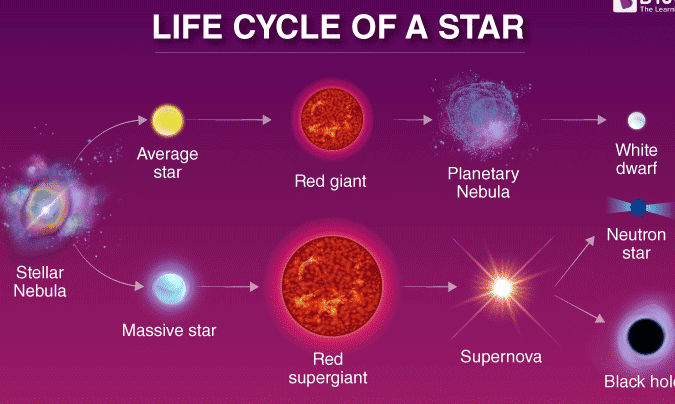Stars, despite appearing eternal and unchanging to us Earthlings, actually undergo a gradual process of evolution. In this article, we will explore the various stages that stars go through during their lifespan.

Phases of stellar development
Every transformation is driven by certain factors that induce the system to undergo change. In the case of stars, the primary factors are gravity and the energy produced by thermonuclear reactions in the core. According to theory, the state of a star is determined by the equilibrium between these forces.
Due to large-scale cosmological processes, variations in matter have emerged in the Universe: some regions have a scarcity of matter, while others consist of scattered gas clouds. Since hydrogen is the most abundant element in the Universe, these clouds are primarily composed of it.
Convective star formation
Under the influence of gravity, the clouds start to condense, creating a region of higher density known as a “protostar”. The more matter that accumulates in the protostar, the stronger its gravitational pull becomes, leading to the faster formation of a dense object.
As the gas gets compressed, its temperature increases in accordance with the laws of gas. This results in the formation of significant temperature variations within the protostar, which triggers vigorous convection of the gas. The hot gas rises to the surface from the core, while the cooled gas descends back to the core. The primary source of energy at this stage is the gravitational compression.
Main Sequence Star
When the temperature inside the core reaches several million degrees, the thermal energy of the atomic nuclei becomes sufficient to overcome the forces of repulsion and come close enough together to initiate nuclear fusion reactions, where hydrogen nuclei combine to form helium nuclei. These reactions release a large amount of energy and are balanced by gravitational forces. The star begins to “ignite” and enters its main phase of evolution.
The star’s luminosity and spectral class are usually closely linked, resulting in the star occupying a specific position on the Hertzsprung-Russell diagram, known as the “main sequence”. This diagonal region represents the stage of stellar evolution that the star is in.
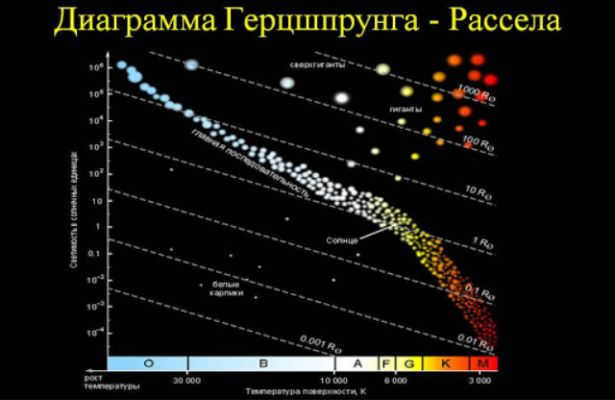
Figure 1. The Hertzsprung-Russell diagram shows the different stages of star evolution.
The length of time a star spends in the main-sequence stage varies depending on its mass. Stars with higher masses consume hydrogen at a faster rate, causing them to progress through this stage more quickly. In contrast, stars with lower masses can remain in the main sequence for billions or even trillions of years.
As the hydrogen supply becomes depleted, the pressure within the star decreases, causing it to lose stability. This leads to the contraction of the inner core once again, resulting in the initiation of new thermonuclear fusion reactions involving helium nuclei merging into carbon, neon, oxygen, and eventually iron nuclei.
In the central region of the star, the temperature is lower, causing the helium fusion reactions to commence at a later stage. This release of energy causes the outer layers of the star to expand. Consequently, the star undergoes the simultaneous formation of a denser, compact core and a less dense, expanding outer shell. Thus, the star transforms into a red giant.
A typical red giant has a size ranging from 100 to 1000 solar radii. If such a star were placed in the solar system, its surface could potentially be positioned near the orbit of Jupiter. However, the average density of a red giant is often lower than that of air.
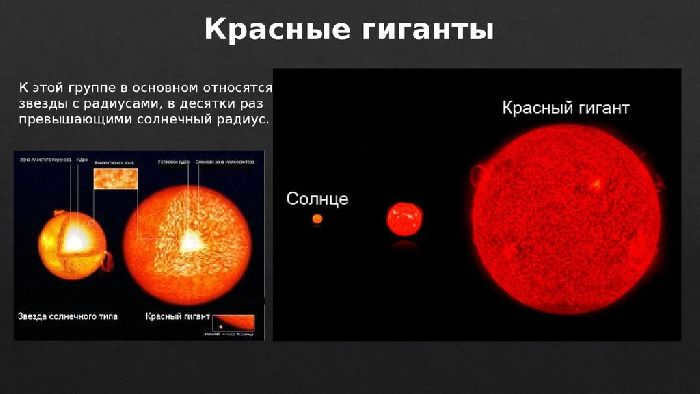
Figure 2. Measurements of red giants.
Final stages of the life cycle
The period of a red giant with a progressively denser core and expanding outer shell lasts from 10 to 100 million years. Afterwards, depending on the specific circumstances, the outer layers may simply disperse or they may detonate, creating a nebula of diverse shapes.
At the center of the nebula remains the core – a white dwarf, neutron star, or black hole, depending on its mass. This signifies the ultimate phase of a star’s life cycle.
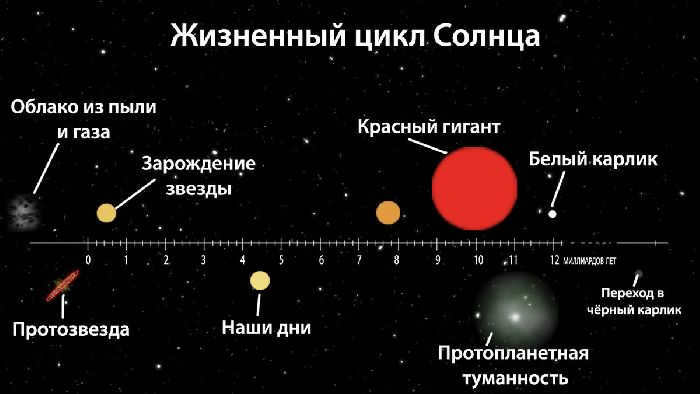
Illustration 3. Phases in the life cycle of the Sun.
What have we discovered?
Gravity and fusion energy are the primary factors influencing the development of a star. These forces drive the star through various stages, including protostar, convective star, main-sequence star, and red giant. The red giant eventually sheds its outer layers in a dramatic explosion, leaving behind a core that can either become a white dwarf, neutron star, or black hole.
The journey of every star starts in a similar fashion to the Sun’s, by condensing an interstellar cloud of gas and particles. Subsequently, the star focuses all its energy on countering gravitational compression. Just like our Sun, stars initially initiate nuclear reactions in their core, generating outward pressure that prevents gravitational collapse. Nearly all visible stars are currently in the hydrogen-burning phase, known as main sequence stars. Our Sun has remained in this stage for approximately 4.5 billion years.
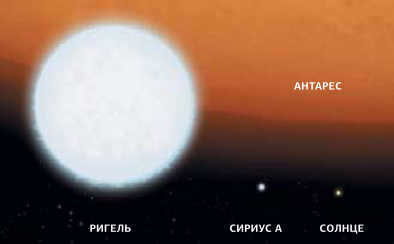
The hot blue star Rigel and the typical stars Sirius A and the Sun against the backdrop of the red supergiant Antares.
The progression of stars based on their mass
Durations of stars with varying masses
- 0.1 solar mass: 6 to 12 trillion years
- 1 solar mass: 10 billion years
- 10 solar masses: 32 million years
- 100 solar masses: 100,000 years
Phases in the development of stars with different masses
- 0.1 solar mass: red dwarf
- 1 solar mass: red giant, then white dwarf
- 10 solar masses: supernova, then black hole
- 100 solar masses: supernova, then black hole
Obviously, the process of hydrogen combustion cannot continue indefinitely. Eventually, the hydrogen fuel within the core of a star is depleted, and the star must discover alternative methods to withstand the forces of gravitational compression. The duration of this phase depends on the mass of the star. Two contrasting effects are observed: firstly, massive stars possess significant reserves of fuel during the initial stages of their evolution; secondly, the gravitational compression force is stronger in larger stars, resulting in an accelerated depletion of nuclear fuel within their interiors. The latter factor prevails: the larger the star, the briefer its duration in the hydrogen burning stage. If we were to consider the age of the Milky Way, stars similar to the Sun would have enough fuel to sustain themselves for approximately 10 months, while very massive stars can only endure for half an hour.

Stars in the Omega Centauri globular cluster.
Red giants

Stars within the globular cluster of Omega Centauri.
Large red stars
What happens to a typical solar-type star when it exhausts the hydrogen in its core? Clearly, the nuclear reactions will diminish and the pressure that has been counteracting gravitational forces for billions of years will decrease. Gravity will take control once again: the star will start to compress, and eventually this compression will reheat its interior. This will cause two things to occur. Firstly, the outer regions of the core, where unburned hydrogen remains, will heat up to temperatures that facilitate the transformation of hydrogen into helium. Secondly, the temperature of the core will increase, and under these conditions, helium, which is the end product of hydrogen combustion, will ignite quickly. In this new cycle, three helium nuclei, each consisting of two protons and two neutrons, will merge to form one carbon nucleus (with six protons and six neutrons) and release excess energy. The type of reactions in which the remnants of one nuclear cycle become the fuel for the next cycle play a crucial role in the energy production of aging stars.
In due course, stars weighing less than 6 solar masses will produce additional energy within their cores by consuming nuclear reserves, resulting in the expansion of their outer layers. As an example, the boundary of the Sun will relocate to the Earth’s orbit. With a larger surface area through which the star’s energy can escape into space, the color of this surface will transition from its current white (as exhibited by the Sun) to red, which is characteristic of hot stars. These stars are known as red giants.
What will occur to Earth once the Sun reaches the red giant stage in 5.5 billion years? It is evident that Mercury and Venus will be engulfed by the Sun and completely evaporate. During this transition, a significant portion of the Sun’s mass will be expelled into the surrounding space, thereby weakening its gravitational pull on the planets. As a result, the Earth’s orbit will gradually shift outward, placing it slightly further from the expanding star’s outer layers and rendering it unaffected by the expansion. However, current calculations indicate that due to tidal effects, our planet will still experience a gradual approach towards the Sun and eventually be assimilated by it. Even if assimilation doesn’t occur, the Earth will become so intensely heated that its oceans will evaporate and the surface rocks will liquefy, obliterating any remaining life.
What comes next? The pressure exerted by stars like the Sun is insufficient to initiate fresh thermonuclear reactions involving the carbon produced earlier by the fusion of helium in the star’s core, making it impossible to prevent gravitational collapse. Gravity will prevail once again, resulting in the collapse.
We are aware that the gravitational compression of the interstellar gas cloud during the Sun’s early development propelled the atoms to such high speeds that the nuclei were stripped of their electrons in violent collisions. Throughout the star’s life cycle, from the main-sequence phase to the red giant phase, these electrons observed the unfolding events and played a crucial role in the processes occurring within the nucleus. Now is their moment to shine.
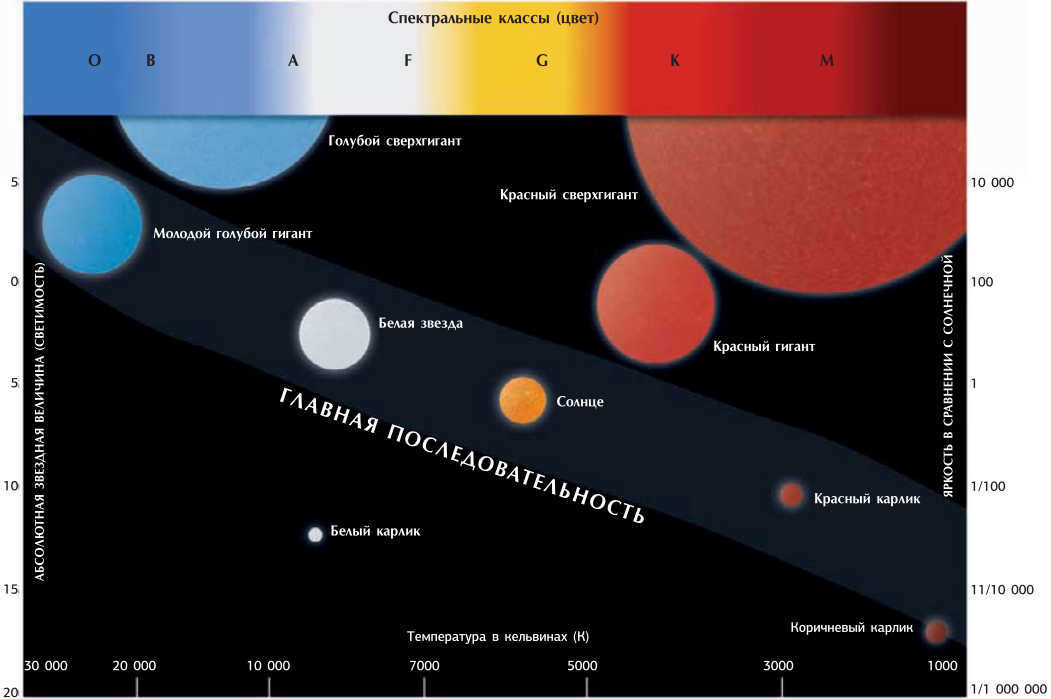

The Hertzsprung diagram, developed by Russell, illustrates the connection between a star’s temperature and its luminosity. As stars transition from the left to the right on the diagram, their temperature decreases, while their radiation brightness decreases as they move from top to bottom. Our Sun, located in the middle of the primary sequence, is a typical example of a star.
The Banning Principle, also known as the Pauli principle, is a crucial property of electrons during a star’s life cycle. It states that two or more electrons cannot occupy the same state simultaneously. To illustrate this, imagine a group of people: you can bring them close together, but once they require a minimum amount of personal space, you cannot further reduce the size of the group. Similarly, when electrons are separated from atomic nuclei, they become so closely packed during the collapse of a star that they reach a point where they cannot be brought any closer. At this stage, gravity attempts to pull them together, but they repel each other, thus determining the star’s stability in its final phase. This stability will endure indefinitely.
The Earth-sized collapse of the Sun will mark its ultimate state of equilibrium. Transforming into a white dwarf, the star will radiate a fiery red hue akin to smoldering embers in a flaming afterglow. Astronomers have coined this celestial entity as a white dwarf, which continues to emit the remnants of the energy it generated throughout its extensive life cycle. However, like dying embers, these dwarf stars gradually fade and cool over time. Such is the fate that awaits our radiant luminary, as well as numerous other stars that grace the night sky.
Nevertheless, bidding farewell to existence isn’t confined to this single path for stars. In the subsequent chapter, we will explore how some stars conclude their lives in far more dazzling and dramatic manners.

At present, 58,744 educational institutions have the opportunity to benefit from extra cumulative discounts ranging from 2% to 25%. To determine the specific discount applicable to all staff members of your educational institution, simply access your personal Infoworks account.
Course for enhancing professional skills
It is possible to include your educational institution’s discount in addition to this discount (the amount depends on the number of your colleagues who have taken Infowork courses).
Currently, there are additional cumulative discounts (ranging from 2% to 25%) available for 58,744 educational institutions. To determine the applicable discount for all employees of your educational institution, please log in to your personal Infoworks account.


Continuing Education Program
Teaching and Nurturing Children with Special Educational Needs (SEN) in a General Educational Setting: The Role of a Teacher-Defectologist
In addition to this offer, your educational institution may also qualify for a discount based on the number of colleagues who have enrolled in Infowork courses.
Currently, a total of 58,744 educational institutions are eligible for additional discounts ranging from 2% to 25%. To determine the discount available to all employees of your educational institution, please login to your personal Infoworks account.


Getting Ready for the Literature USE. Exploring the Works of I. S. Turgenev
Overview of the Presentation by Slide:

Slide 2: The cosmos is composed of 98% celestial bodies. They also serve as the fundamental components of a galaxy.
"Celestial bodies are massive spheres comprising helium, hydrogen, and other gases. "Gravity attracts them
"while the intense heat and pressure of the gas counterbalance, establishing a state of equilibrium. The core of a celestial body houses its energy, where helium and hydrogen undergo continuous interaction."

Slide 3: The life cycle of stars is a complete journey – birth, growth, a period of relatively calm activity, turmoil, death, and it bears resemblance to the life cycle of an individual organism.
Astronomers face the challenge of tracing the full life story of a single star. Even the shortest-lived stars endure for millions of years – longer than the lifetime of not just one individual, but the entire human race. However, scientists have the ability to observe multiple stars in various stages of development – just being born and nearing the end. Through studying numerous stellar portraits, they strive to reconstruct the evolutionary path of each star and pen its biography.
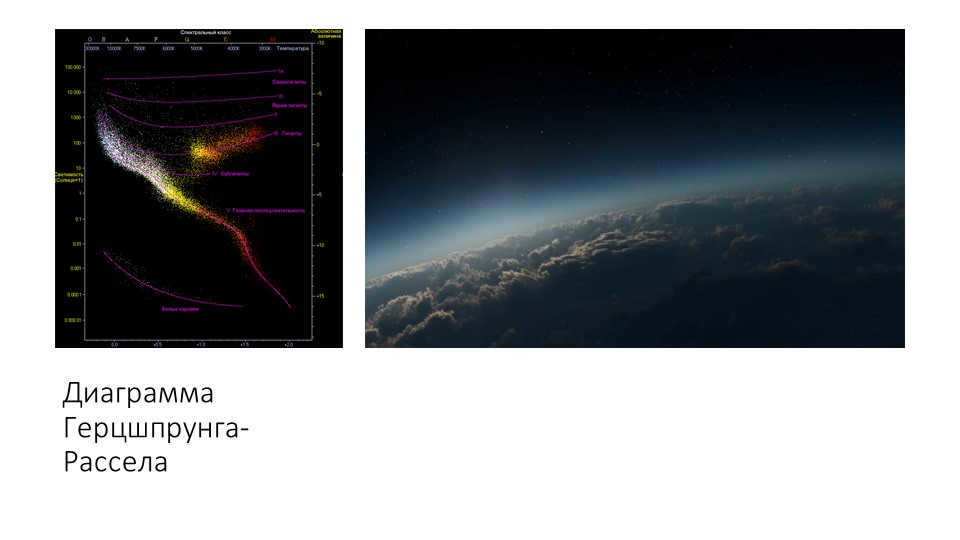
On the fifth slide, you can find the Orion Nebula, which is a vibrant emission nebula that has a greenish tint. It is situated just below Orion’s Belt.
This remarkable celestial sight can even be observed without the aid of a telescope.
It is located approximately 1300 light-years away from Earth and spans an impressive 33 light-years in size.
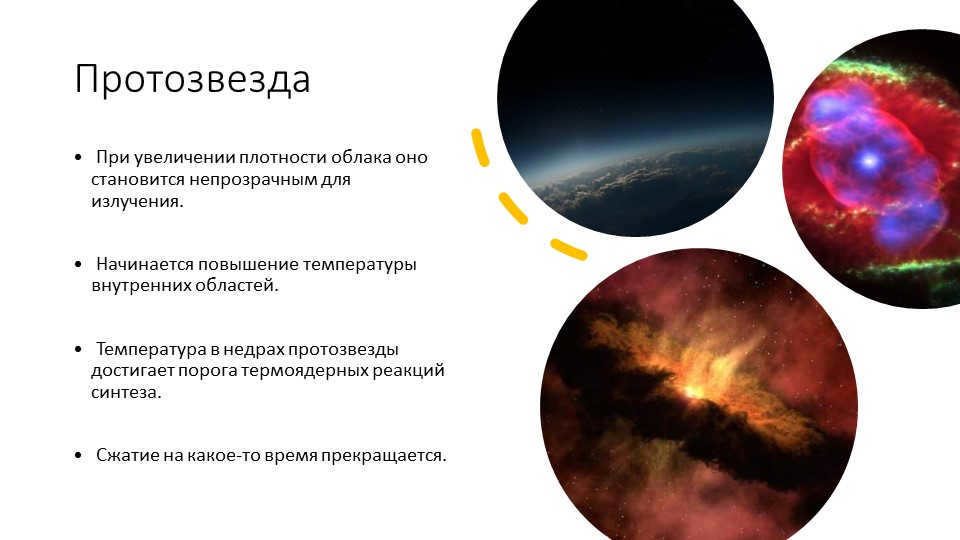
Slide 6 Protostar.
As the density of the cloud rises, it becomes less transparent to radiation.
The temperature of the inner regions starts to increase.
The temperature within the protostar’s core reaches the threshold for thermonuclear fusion reactions.
The compression halts temporarily.

During the seventh stage, the star reaches a state of equilibrium.
The youthful star has now reached the main sequence on the G-P diagram.
The process of hydrogen burning, which is the main nuclear fuel for stars, has commenced.
Compression is almost non-existent and the energy reserves are no longer fluctuating.
The central regions of the star are experiencing a gradual change in chemical composition as hydrogen is transformed into helium.
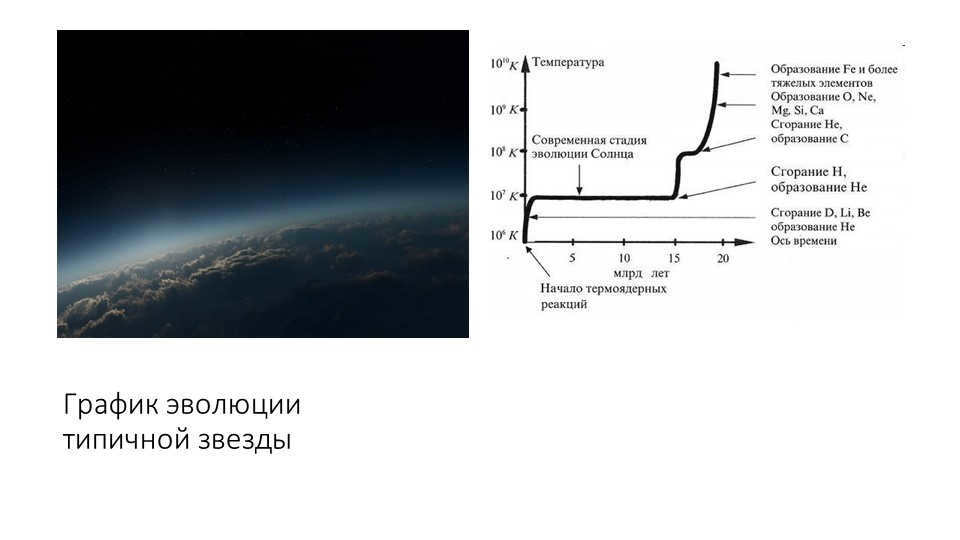

9 slide Giants and supergiants.
As hydrogen is fully consumed, the star transitions from the main sequence to the domain of giants or, in the case of high masses, supergiants.


After all of the nuclear fuel has been completely consumed, the gravitational collapse phase commences. For stars with a mass less than 1.4 times that of the Sun, they transform into white dwarfs. During this stage, the electrons come together to form a degenerate electron gas. The gravitational collapse eventually halts, resulting in a density of a few tons per cm3, while the temperature remains at around 10^4 K. Over the course of millions of years, the white dwarf gradually cools down and contracts. Eventually, it reaches a point where it becomes a black dwarf.
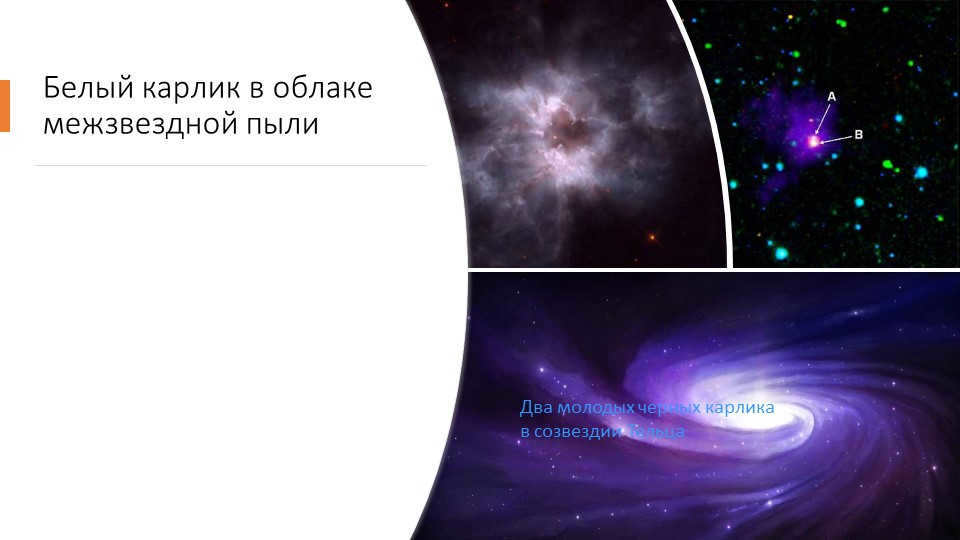
12 slide star mass > 1.4 solar masses:
Gravitational compression exerts immense pressure, causing matter to reach a density of one million tons per cm3. This results in the release of a tremendous amount of energy, estimated at 10^45 J. Additionally, the temperature soars to approximately 10^11 K, leading to a supernova explosion.
During the supernova event, the majority of the star is expelled into space at velocities ranging from 1000 to 5000 km/sec. Meanwhile, streams of neutrinos help cool the core of the star, ultimately leading to the formation of a neutron star.


Reflection on Slide 15
What is the term used to describe the process of stars changing over time?
What knowledge is required to determine the age of a star in a dispersed cluster?
What are the different classifications for stars, such as giants, supergiants, and dwarfs?
What factors influence the color and spectrum of a star?
By how many times does the brightness of stars that undergo a supernova explosion increase?
How long would it take for the Sun to emit the same amount of energy released in a supernova explosion? (Approximately 8 million years)
What are the final stages of stellar evolution?
Is it possible for a star with a mass of 0.1 M to become a red supergiant during its evolution? What about a blue supergiant?
Worksheets and materials for educators and teachers
Over 10,000 teaching resources for both classroom and at-home learning

The Universe is a dynamic macrocosm where every object, substance, or matter undergoes continuous transformation and alteration. These processes endure for billions of years. In comparison to a human lifespan, this incomprehensible time frame is immense. On a cosmic scale, these alterations are relatively fleeting. The stars that we currently observe in the nighttime sky were the same thousands of years ago when they were visible to the Egyptian pharaohs. However, throughout this entire time, the physical characteristics of celestial luminaries have never ceased to change even for a moment. Stars are birthed, exist, and inevitably age – the evolution of stars follows its own unique path.

The arrangement of stars in the Big Dipper has changed over time, with different positions observed in different historical periods spanning a range of 100,000 years. This evolution will continue, with further changes expected in the next 100,000 years.
Understanding the evolution of stars through a layperson’s perspective
To the ordinary individual, the cosmos may seem like a serene and silent realm. However, in reality, the Universe is an immense physical laboratory where enormous metamorphoses occur, altering the chemical makeup, physical properties, and structure of stars. The existence of a star persists as long as it radiates light and emits heat. Nevertheless, this dazzling phase is not eternal. The luminous birth is succeeded by a stage of stellar adulthood, which inevitably culminates in the senescence of the celestial entity and its demise.
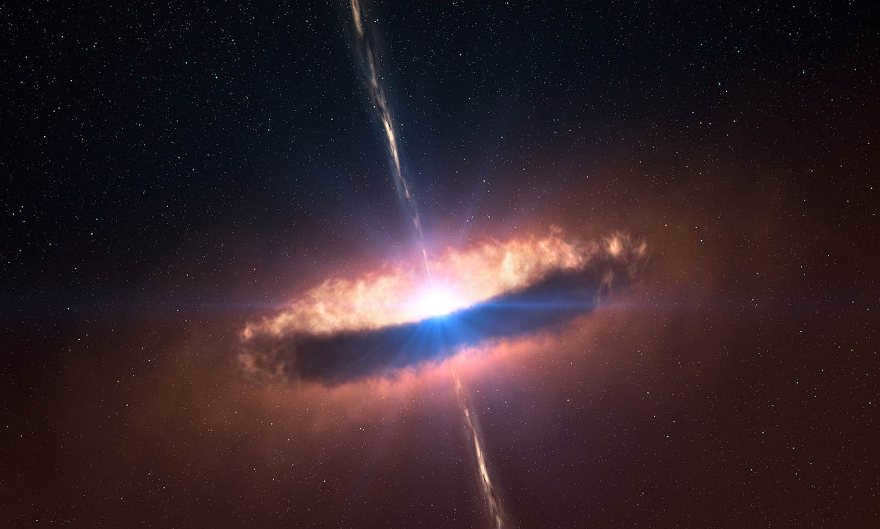
Approximately 5-7 billion years ago, a protostar began to form from a cloud of gas and dust.
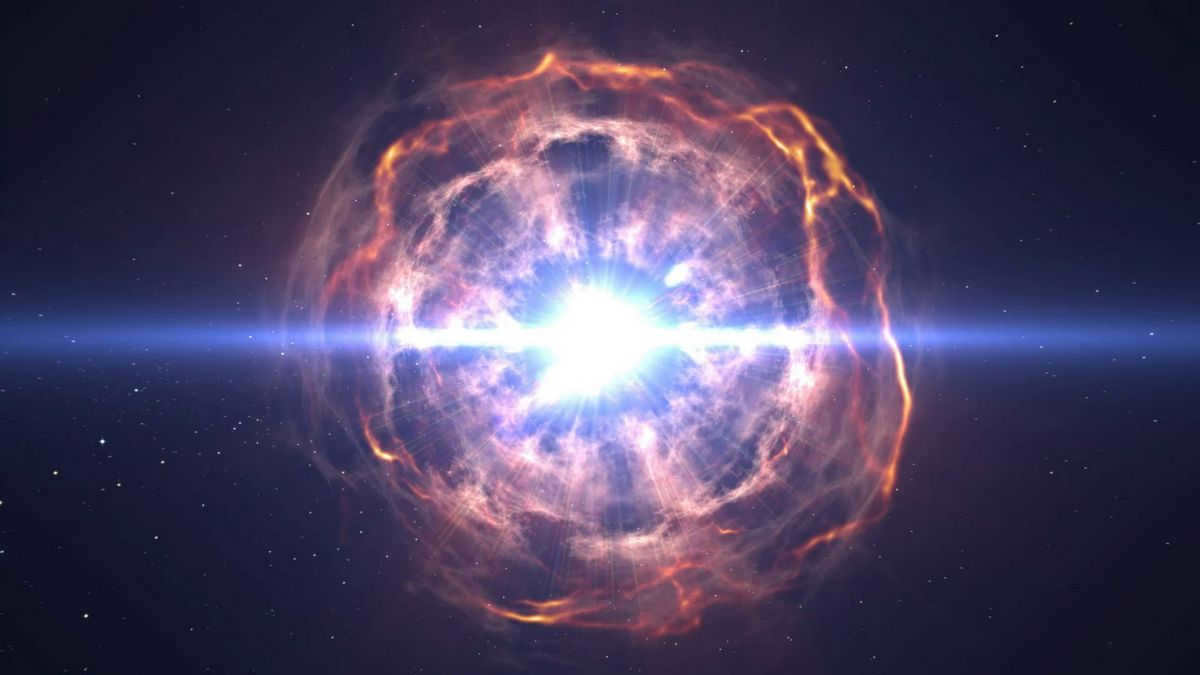
The explosion of a supernova marks the dazzling end of a star’s life that was born during the early years of the Universe.
The changes in the physical properties of stars are determined by their mass. The rate at which objects evolve is influenced by their chemical composition and, to some extent, by the astrophysical parameters such as rotation rate and magnetic field state. Due to the immense duration of these processes, it is difficult to precisely describe how everything unfolds in reality. The rate of evolution and the stages of transformation depend on the star’s birth time and its position in the Universe at that time.
The scientific perspective on the evolution of stars
Each star originates from a cluster of frigid interstellar gas, which, due to both external and internal gravitational forces, undergoes compression and transforms into a gas sphere. The process of gas substance compression is continuous and accompanied by an immense release of thermal energy. The temperature of the emerging celestial body continues to increase until thermonuclear fusion is ignited. At that point, the compression of stellar matter halts, and a balance between the object’s hydrostatic and thermal state is achieved. Thus, the Universe is enriched with a brand new, fully-formed star.
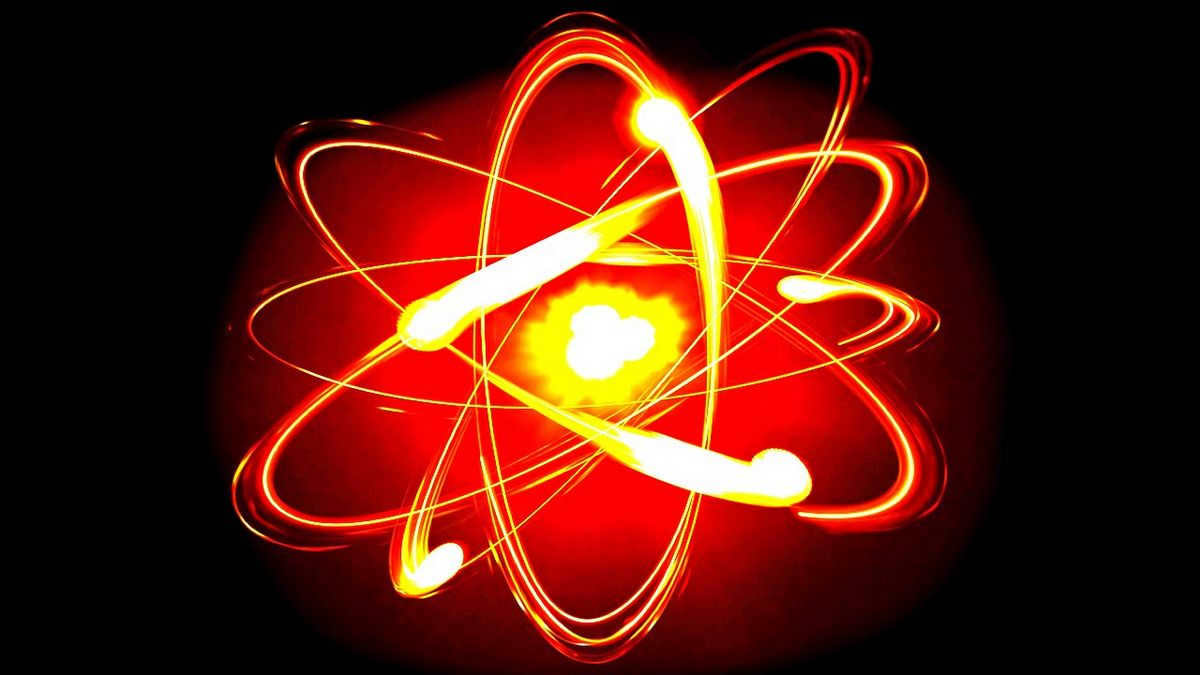
The primary source of energy for stars is the hydrogen atom, which undergoes a thermonuclear reaction to produce heat and light.
The sources of thermal energy are crucial in the evolution of stars. The star’s surface emits radiant and thermal energy, which is then replenished by cooling the inner layers of the celestial luminary. The loss of energy is compensated by constant thermonuclear reactions and gravitational compression in the star’s interior. As long as there is sufficient nuclear fuel inside the star, it will shine brightly and emit heat. However, when the process of thermonuclear fusion slows down or ceases, the star’s internal compression mechanism takes effect in order to maintain thermal and thermodynamic equilibrium. At this stage, the star emits thermal energy that is only visible in the infrared range.
- nuclear time scale;
- thermal interval of a star’s life;
- dynamic interval (final) of the luminary’s life.
Each of these cases explores the processes that govern a star’s age, its physical characteristics, and the manner in which it meets its demise. The nuclear timescale becomes relevant when a star is powered by its own internal heat sources and emits energy as a result of nuclear reactions. To estimate the duration of this phase, scientists calculate the amount of hydrogen that will be converted into helium through the process of fusion. The more massive the star, the more intense the nuclear reactions, resulting in a higher luminosity for the star.
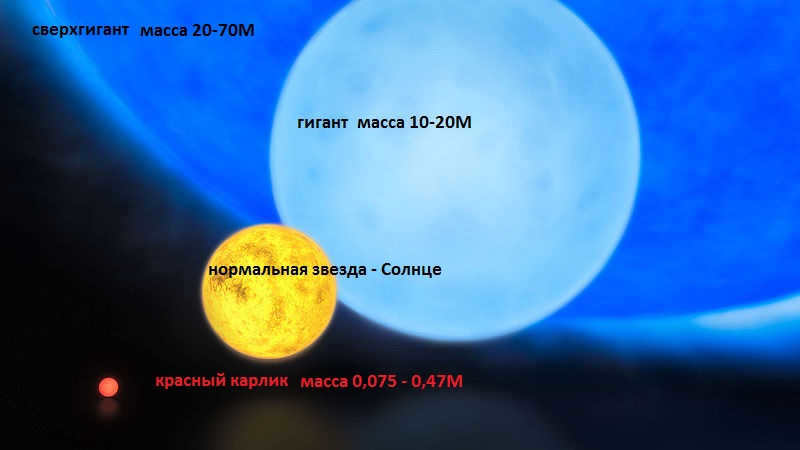
Different stars, varying in size and mass, go through various stages of evolution. These stages are defined by the star’s thermal timescale, which is the period during which the star depletes all of its thermal energy. This process begins when the star exhausts its hydrogen reserves and nuclear reactions cease. In order to maintain equilibrium, a compression process is initiated, causing stellar matter to fall towards the center. Simultaneously, kinetic energy is converted into thermal energy, which is used to sustain the necessary temperature balance within the star. Some of this energy is released into space.
A star during its journey towards the main sequence
Considering the fact that the mass of a star determines its luminosity, the object’s brightness in space remains unchanged during the compression process.
A star is formed through a dynamic timeline, as stellar gas gravitates towards the center, increasing the density and pressure within the future celestial object. The higher the density at the core of the gas mass, the hotter the temperature within the object. Heat then becomes the primary source of energy for the celestial body. As density and temperature increase, so does the pressure within the future star. Eventually, the free fall of molecules and atoms halts, and the compression of the stellar gas comes to a pause. This stage is commonly referred to as a protostar, which consists of approximately 90% molecular hydrogen. Once the temperature reaches 1800K, the hydrogen transitions into an atomic state. This transformation consumes energy and slows down the temperature increase.
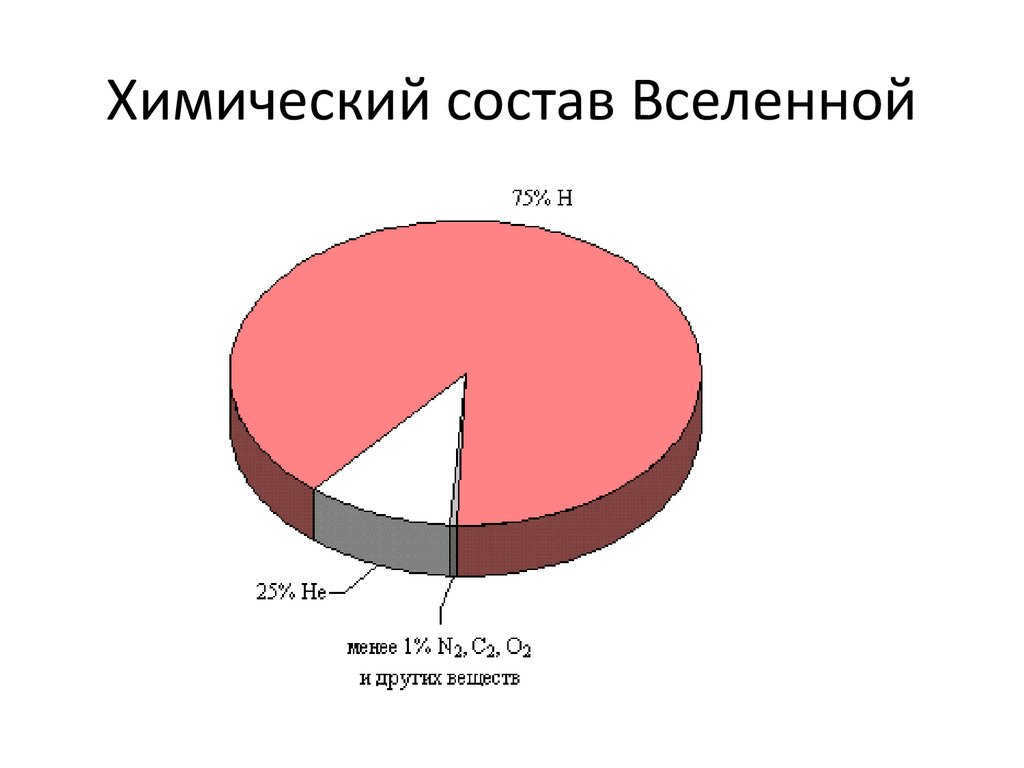
The majority of the Universe is composed of molecular hydrogen, constituting 75% of its total composition. This molecular hydrogen undergoes a transformation into atomic hydrogen during the formation of protostars. Atomic hydrogen serves as the nuclear fuel for stars.
During this transformation, the pressure inside the gas ball decreases, allowing for the compressive force to exert its influence. This process repeats itself, with all hydrogen ions becoming ionized first, followed by the ionization of helium. When the temperature reaches 10⁵ K, the gas is completely ionized, resulting in the cessation of star compression and the establishment of hydrostatic equilibrium within the star. From this point on, the star’s evolution will follow the thermal timescale, a slower and more consistent process.
The protostar’s radius decreases from 100 a.u. to ¼ a.u. as it forms in the center of a gas cloud. As particles from the outer regions of the gas cloud accrete onto the protostar, its mass steadily increases. This leads to a rise in temperature inside the protostar, and convection begins to transfer energy from the star’s inner layers to its outer edge. Eventually, as the temperature in the protostar’s interior continues to rise, radiative transfer takes over and energy is emitted from the star’s surface. This causes a rapid increase in the object’s luminosity and the temperature of its surface layers.
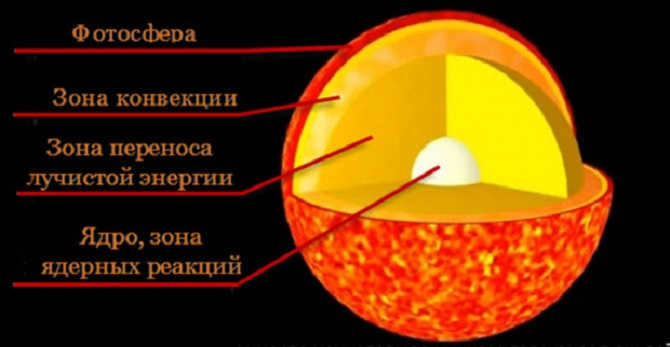
Convection and radiative transfer processes occur in a newly formed star before fusion reactions begin.
For instance, in stars with the same mass as our Sun, the protostellar cloud undergoes compression in just a few hundred years. On the other hand, the condensation of stellar matter during the final stage of object formation takes millions of years. The Sun transitions to the main sequence relatively quickly, but this process can take hundreds of millions or even billions of years. In other words, the more massive a star is, the longer it takes to form a fully-fledged star. A star with a mass of 15M will require a much longer period, approximately 60 thousand years, to reach the main sequence.
Main-sequence phase
While there are fusion reactions that can occur at lower temperatures, the primary stage of hydrogen combustion initiates at a temperature of 4 million degrees Celsius. At this juncture, the main-sequence phase commences. A novel mode of stellar energy generation becomes operative – nuclear energy. The kinetic energy liberated during the compression of the celestial object diminishes. The attained state of equilibrium guarantees an extended and tranquil existence for the star, which finds itself in the nascent stage of the main-sequence phase.
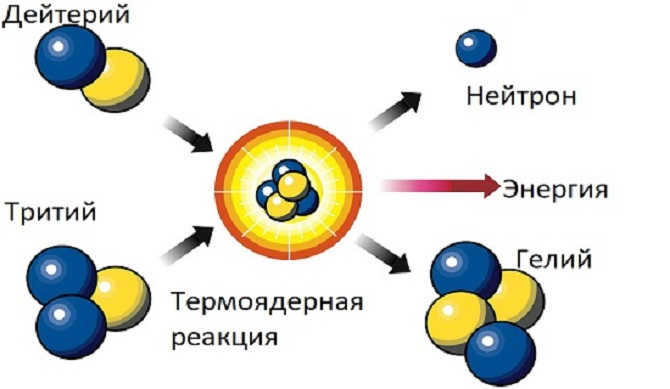
The thermonuclear reaction that takes place within a star’s core involves the fission and decay of hydrogen atoms.
Stars of smaller size have a longer duration of burning in the dark sky. Therefore, a star with a mass of 0.25M will continue to exist in the main sequence stage for billions of years.
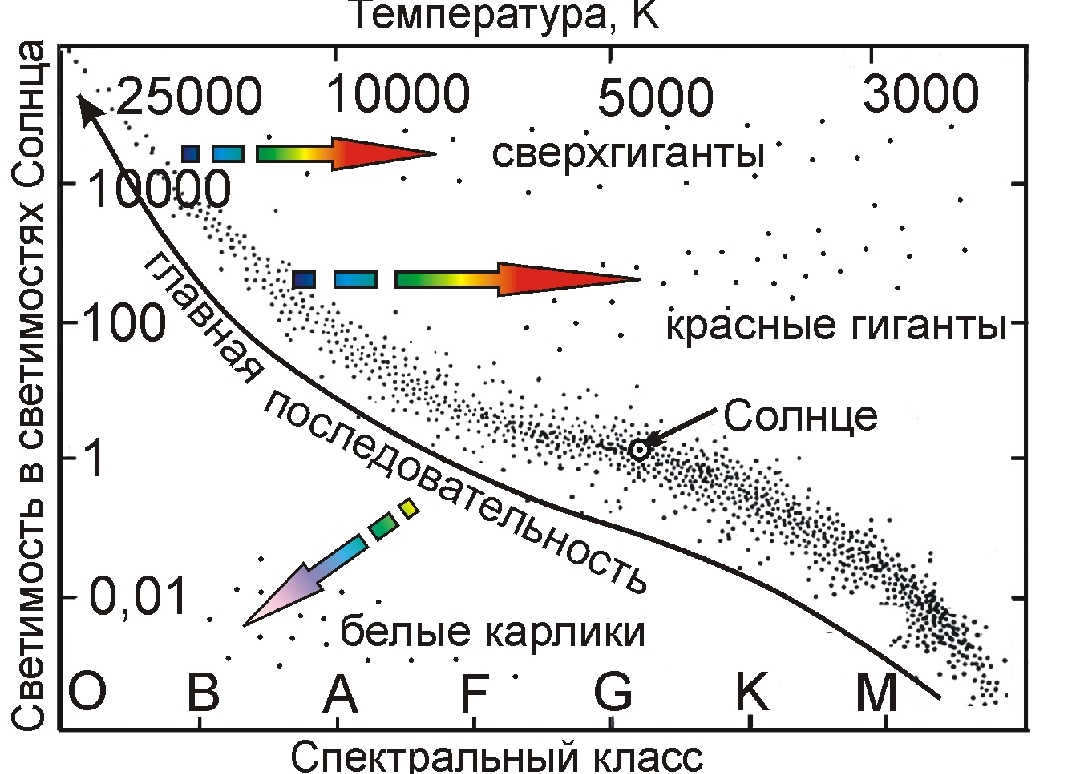
The Hertzsprung-Russell diagram is a tool that helps us understand the relationship between the spectrum of stars and their luminosity. The dots on the diagram represent the known stars, and the arrows show how stars move away from the main sequence and into the stages of giants and white dwarfs.
To get a better understanding of how stars evolve, we can simply focus on the main sequence part of the diagram. The upper section of the chart appears less populated because it is where we find massive stars. These stars have shorter lifecycles, which explains their concentration in this region. It is worth noting that among the stars we know of, some have masses as high as 70M. However, objects with a mass exceeding the upper limit of 100M may not form at all.
Celestial bodies weighing less than 0.08M lack the ability to surpass the necessary critical mass to trigger thermonuclear fusion, and consequently, they remain cool throughout their existence. The tiniest protostars undergo contraction to eventually become dwarf stars resembling planets.
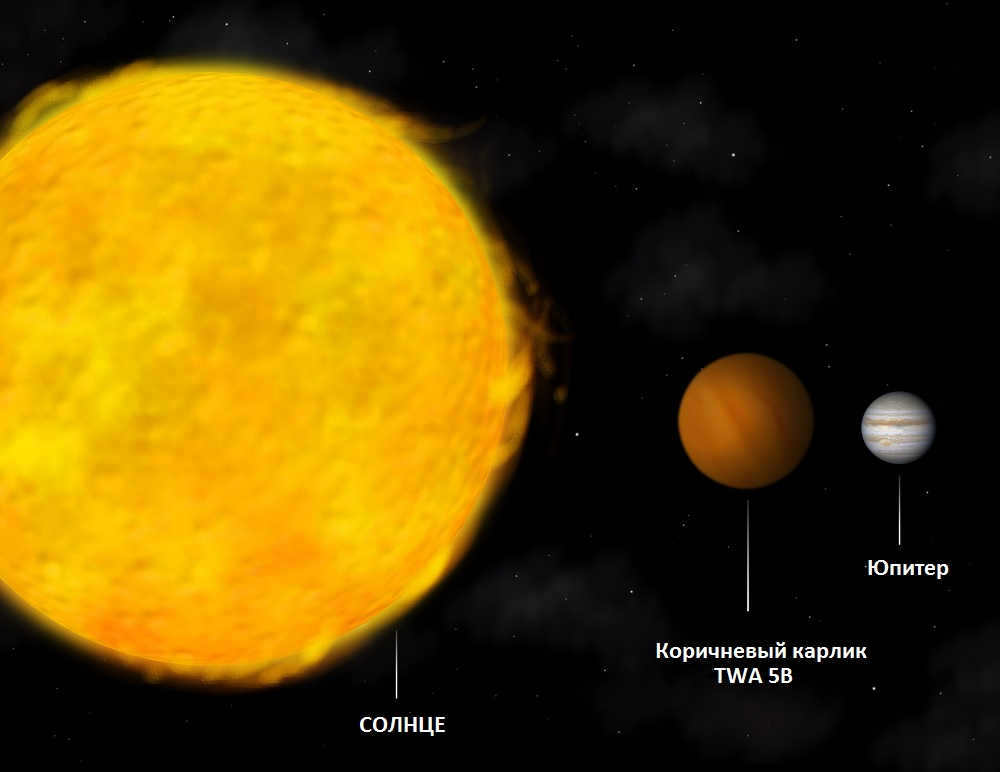
A comparison is made between a planet-like brown dwarf and a normal star (our Sun) and the planet Jupiter.
The bottom section of the sequence focuses on objects that are primarily stars with masses equal to or slightly larger than our Sun. The dividing line between the upper and lower sections of the main sequence represents objects with a mass of approximately -1.5M.
Each star’s destiny is determined by its mass and the duration of stellar matter transformation. Nevertheless, the Universe is a complex and diverse mechanism, allowing for various paths in star evolution.
While traversing the main sequence, a star with a mass similar to the Sun has three primary choices:
- to peacefully live out its existence in the vast reaches of the cosmos;
- to enter the red giant phase and gradually age;
- to transition into a white dwarf, undergo a supernova explosion, and transform into a neutron star.
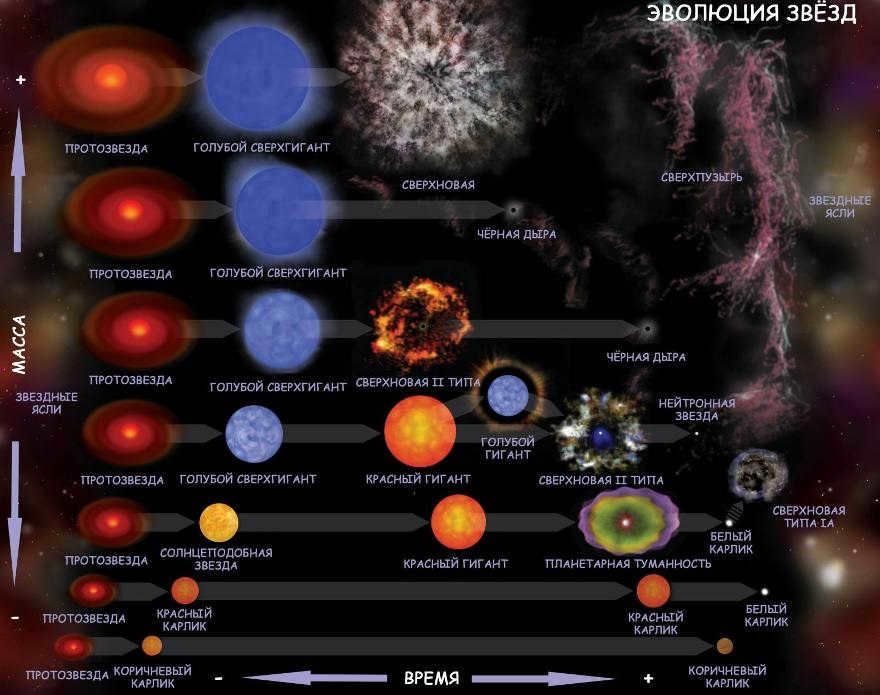
Possible scenarios of protostellar development vary depending on the time, chemical composition, and masses of the objects.
Following the main sequence phase, the star enters the giant stage. At this point, the star’s interior has depleted its hydrogen reserves entirely, leaving behind a helium core. Thermonuclear reactions now occur on the star’s surface, as the shell expands while the mass of the helium core increases. This transformation turns an ordinary star into a red giant.
The unique characteristics of the giant phase
Low-mass stars undergo a transformation where the core density becomes immense, causing the stellar matter to become a degenerate relativistic gas. Once the star’s mass exceeds 0.26M, the increase in pressure and temperature triggers helium fusion, enveloping the entire central region of the star. As a result, the temperature of the star rapidly escalates. A notable characteristic of this process is that the degenerate gas lacks the ability to expand. Due to the high temperature, the rate of helium fission intensifies, leading to an explosive reaction. These instances are known as helium flashes. The object’s brightness surges by hundreds of times, yet the star’s suffering persists. The star undergoes a transition to a new state where all thermodynamic processes occur within the helium core and the rarefied outer shell.
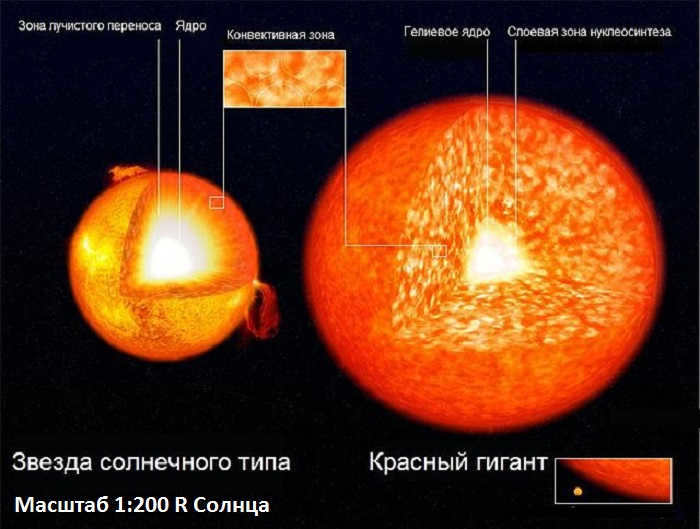
The configuration of a star on the main sequence, similar to our Sun, and a red giant, with a helium core that maintains a constant temperature and a region where nucleosynthesis occurs in layers, has been depicted.
This phase is transitory and does not exhibit stability. The material within the star is in constant motion, and a considerable portion of it is expelled into the surrounding space, forming a planetary nebula. At the center, a hot core remains, known as a white dwarf.
For massive stars, the aforementioned processes are less destructive. Instead of helium burning, carbon and silicon undergo nuclear fission reactions. Ultimately, the core of the star will transform into iron. The phase of a giant star is determined by its mass. As the object’s mass increases, the temperature at its center decreases. This temperature decrease is insufficient to initiate nuclear fission reactions involving carbon and other elements.
When a white dwarf reaches a certain point, it becomes extremely unstable. The decrease in pressure causes the nucleus to collapse, resulting in terminated nuclear reactions. During this collapse, energy is released as iron decays into helium atoms, which then decay into protons and neutrons. This process happens very quickly. The collapse of a star is a dynamic event that takes only a fraction of a second. The remaining nuclear fuel ignites explosively, releasing a massive amount of energy in an instant. This energy is enough to blow off the outer layers of the star. The final stage of a white dwarf is a supernova explosion.
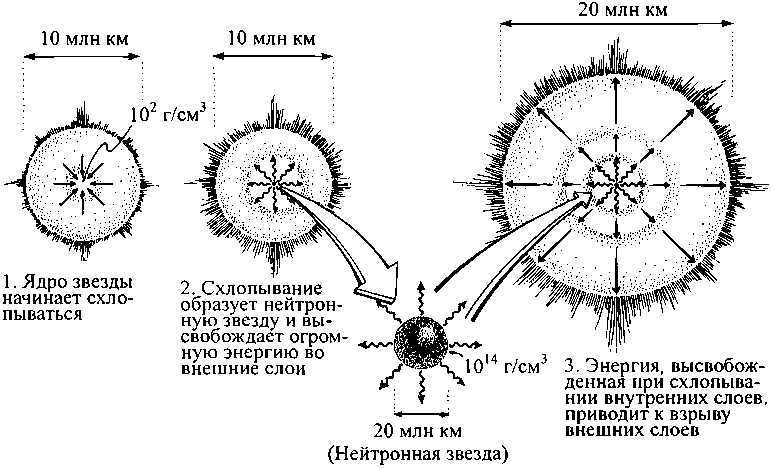
The star’s core initiates a collapse (on the left). This collapse results in the formation of a neutron star and generates an energy outflow towards the star’s outer layers (in the middle). The outer layers of the star collapse in a supernova explosion, releasing energy (on the right).
The remaining superdense nucleus consists of protons and electrons, which collide and transform into neutrons. This gives rise to a new entity in the Universe – a neutron star. Due to its high density, the core becomes degenerate, halting the process of core collapse. If the star’s mass is sufficiently large, the collapse may continue until the remnants of stellar matter ultimately collapse at the object’s center, resulting in the formation of a black hole.
Understanding the last phase of stellar development
In the case of regular stars in equilibrium, the mentioned processes of evolution are improbable. However, the presence of white dwarfs and neutron stars provides evidence of the actual occurrence of compression processes in stellar matter. The limited number of such entities in the Universe indicates the fleeting nature of their existence. The ultimate phase of stellar development can be depicted as a sequential progression of two kinds:
- typical star – red giant – shedding of outer layers – white dwarf;
- massive star – red supergiant – supernova explosion – neutron star or black hole – nothingness.

This diagram illustrates the various stages of stellar evolution beyond the main sequence.
The birthplaces of stars, known as interstellar bubbles and gas-dust clouds, cannot solely rely on disappeared and exploded stars for replenishment. The universe and galaxies are in a state of equilibrium, where there is a continuous loss of mass and a decrease in density of interstellar space in certain parts of outer space. As a result, conditions are created in other regions of the Universe for the formation of new stars. In essence, this scheme operates by redistributing matter: if a certain amount of matter is lost in one location, an equal amount of matter appears in another part of the Universe in a different form.

